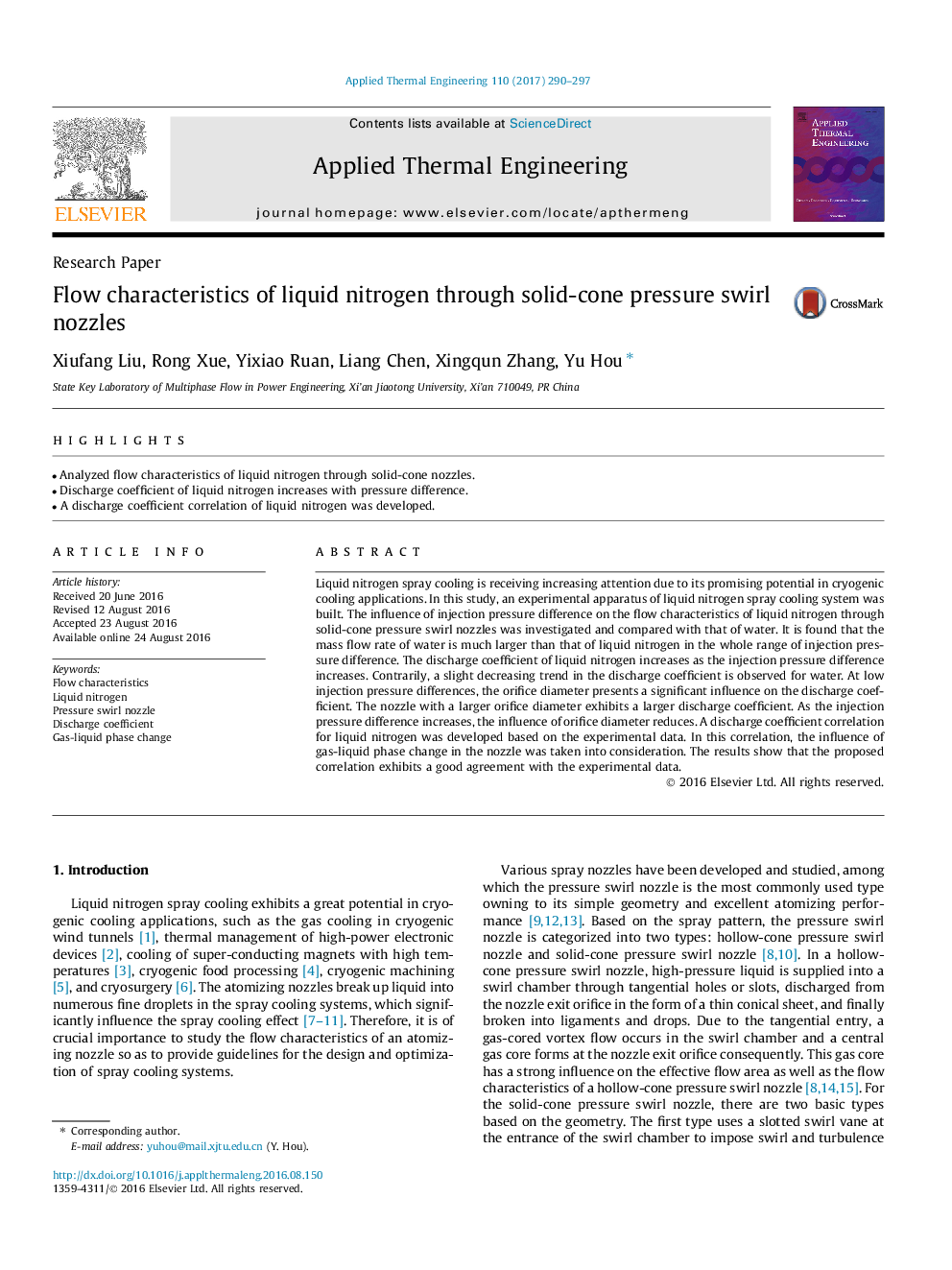| کد مقاله | کد نشریه | سال انتشار | مقاله انگلیسی | نسخه تمام متن |
|---|---|---|---|---|
| 4992016 | 1457119 | 2017 | 8 صفحه PDF | دانلود رایگان |
عنوان انگلیسی مقاله ISI
Flow characteristics of liquid nitrogen through solid-cone pressure swirl nozzles
ترجمه فارسی عنوان
ویژگی های جریان نیتروژن مایع از طریق نازل های چرخش مخروطی
دانلود مقاله + سفارش ترجمه
دانلود مقاله ISI انگلیسی
رایگان برای ایرانیان
کلمات کلیدی
ویژگی های جریان، نیتروژن مایع، نازل چرخش فشار، ضریب تخلیه، تغییر فاز گاز و مایع،
ترجمه چکیده
خنک کننده اسپری نیتروژن مایع به دلیل پتانسیل امیدبخش در برنامه های خنک کننده یخبندان، توجه بیشتری را به خود جلب می کند. در این مطالعه یک دستگاه آزمایشی از سیستم خنک کننده نیتروژن مایع ساخته شده است. اثر اختلاط فشار تزریق بر خصوصیات جریان نیتروژن مایع از طریق نازلهای چرخشی مخروطی مخروطی مورد بررسی و مقایسه آن با آب قرار گرفت. یافته شده است که جریان جریان جرمی آب بسیار بزرگتر از نیتروژن مایع در کل طیف وسیعی از فشار فشار تزریق است. ضریب تخلیه نیتروژن مایع به دلیل افزایش فشار تزریق افزایش می یابد. به طور خلاصه، یک روند کاهش اندکی در ضریب تخلیه برای آب مشاهده شده است. در فشارهای کم فشار تزریق، قطر سوراخ تاثیر قابل توجهی بر ضریب تخلیه دارد. نازل با قطر بزرگتر دیافراگم ضریب ترمینال ترمینال را نشان می دهد. همانطور که افزایش فشار تزریق افزایش می یابد، تاثیر قطر سوراخ کاهش می یابد. یک رابطه ضریب تراز برای نیتروژن مایع بر اساس داده های تجربی تهیه شد. در این همبستگی، تأثیر تغییر فاز گاز-مایع در نازل مورد توجه قرار گرفت. نتایج نشان می دهد که همبستگی پیشنهادی با داده های آزمایشگاهی توافق خوبی را نشان می دهد.
موضوعات مرتبط
مهندسی و علوم پایه
مهندسی شیمی
جریان سیال و فرایندهای انتقال
چکیده انگلیسی
Liquid nitrogen spray cooling is receiving increasing attention due to its promising potential in cryogenic cooling applications. In this study, an experimental apparatus of liquid nitrogen spray cooling system was built. The influence of injection pressure difference on the flow characteristics of liquid nitrogen through solid-cone pressure swirl nozzles was investigated and compared with that of water. It is found that the mass flow rate of water is much larger than that of liquid nitrogen in the whole range of injection pressure difference. The discharge coefficient of liquid nitrogen increases as the injection pressure difference increases. Contrarily, a slight decreasing trend in the discharge coefficient is observed for water. At low injection pressure differences, the orifice diameter presents a significant influence on the discharge coefficient. The nozzle with a larger orifice diameter exhibits a larger discharge coefficient. As the injection pressure difference increases, the influence of orifice diameter reduces. A discharge coefficient correlation for liquid nitrogen was developed based on the experimental data. In this correlation, the influence of gas-liquid phase change in the nozzle was taken into consideration. The results show that the proposed correlation exhibits a good agreement with the experimental data.
ناشر
Database: Elsevier - ScienceDirect (ساینس دایرکت)
Journal: Applied Thermal Engineering - Volume 110, 5 January 2017, Pages 290-297
Journal: Applied Thermal Engineering - Volume 110, 5 January 2017, Pages 290-297
نویسندگان
Xiufang Liu, Rong Xue, Yixiao Ruan, Liang Chen, Xingqun Zhang, Yu Hou,
